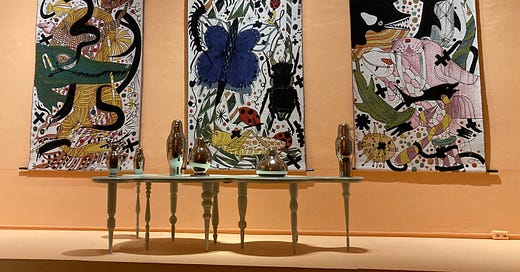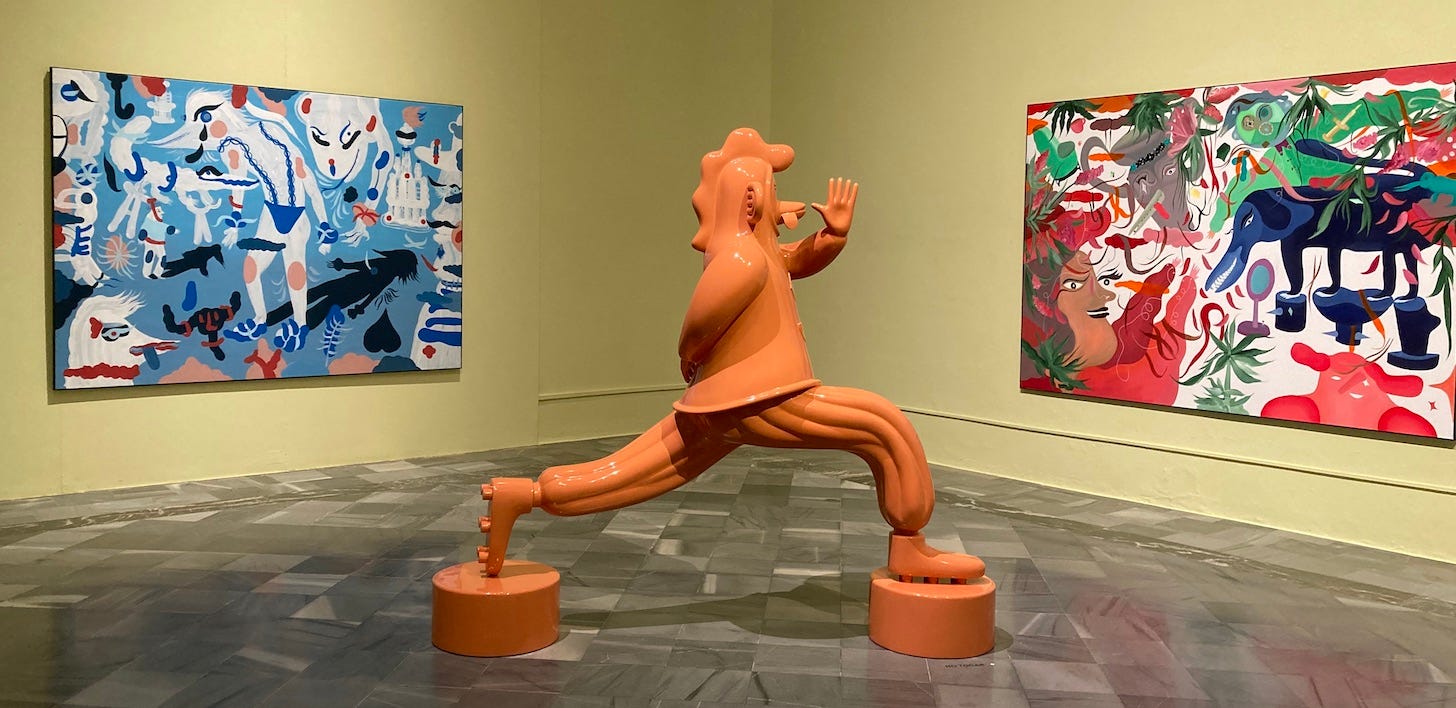In this Substack we celebrate the art and craft of Place Writing. Do you want to be inspired? Join our band of readers and writers who love everything about place and home. Subscribe now and get fortnightly posts delivered to your in-box for free.

Much Place Writing focuses on travelling and exploring outdoors in nature, yet there is no doubt in my mind that the contained interior space of a house is a similarly worthy subject. Before becoming thoroughly immersed in creative non-fiction I was an interior design consultant, and it was through my love of art, architecture, and design, that I began my journey as a place writer.
During my career I met artist-designer Jaime Hayon; his studio-workshop is in Valencia, Spain, a city I adore. Recently, I made a return visit to see the first major retrospective of his work at CCCC (Centro del Carmen de Cultura Contemporánea). The building, in Carrer del Museu, was once a thirteenth century convent and it offers a calm backdrop to Hayon’s colourful and humorous work. The retrospective is dazzling for its technical and artistic ambition, and the quantity and variety of work on display is totally beguiling.
The experience of staying put during Covid lockdowns made us all re-evaluate home as a place of shelter, safety, and comfort. Unable to travel, Hayon used this time to revert to his first artistic pursuit, that of painting. He made five large format pieces during his confinement; these are displayed in one room along with two sculptures made from lacquered fibreglass which, to quote from the gallery label, ‘are like characters who have stepped out of one of the paintings into another physical dimension. They convey a critical view of the world and of life: despite using friendly, even cheerful colours, what they represent is [sic] somewhat jaded characters, tired of the struggle and overwhelmed by circumstances.’

Most of Hayon’s creative output is decorative; from glassware and pots to paintings and objects d’art. However, he has produced some whacky designs for practical items such as furniture and household utensils. Versatile and durable objects include chairs, tables, cutlery, and lighting. Unfortunately these things are not within the budget of ordinary folk like me, but I can aspire to creating a home that has similar vibes. His work is so visually appealing it is easy to live with; it has humour, rounded shapes, lots of colour, soft tactility, a variety of textures, and repeated motifs.
Picking up on an earlier Substack post, Talking Place, where I listed five recurring concepts in Place Writing, I think three are relevant to writing about home:-
The location becomes a target for the laying down of memories, and the subsequent unpacking of them. There are infinite possibilities to personalise homes with objects of meaning. However, connotations of home can be positive and negative and, subject to taking care of one’s own wellbeing, place writers can consider addressing their subject from all angles, even the darker ones. Home can be a container, or a location, or both. By reverting to a craft he knew well, Hayon laid down new memories at home during lockdown.
We investigate human and non-human engagement with place and aim to understand feelings of belonging. The strange ‘life’ forms in Hayon’s work are reminders that non-humans inhabit the spaces of home, for example, pets, insects, and vegetation. I bought a Victorian washstand more than forty years ago, which is both practical and beautiful, but woodworm holes were in evidence. I couldn’t let the critters stay so I treated the wood with some awful liquid. The piece of furniture, which must now be nearly a hundred and fifty years old, smells of stale cigars and cedar wood (though I think it is made from pine). It has moved from place to place with me and, each time I relocate, it helps me feel ‘at home’.
When writing about place, benefits can be obtained by putting time and distance between the research and being-in-place and the remembering of experiences. You’ll have gathered I’ve moved house several times. In my dreams I find myself experiencing alternative versions of the houses I’ve lived in. Memories of home jumble up in the sub-conscious and a rickety staircase or a hidden room elicit a sense of uncertainty. I’m sure dream interpreters would say this is not unusual. Dreams, or altered states of reality, can be used to create new narratives about place.
I’m currently undertaking renovations in my small, new-to-me, home, and when they’re finished I hope it will be a place where I can lay down memories and evolve as a person. I have a palette of soft colours to decorate with and I’m filling my simple box with art that makes me happy. And, when the washstand has been in situ for a while, I will surely find a new sense of belonging. With each passing year my emotional attachment will grow stronger.
Did you manage a creative project during lockdown?
Do you own an item of art or furniture that means a lot to you?
Credits & Links:
The Jaime Hayon INFINITAMENTE exhibition is on until 16th April 2023.
All photos are my own.






Thank you so much for your support and kind words, Yasmin. Best of luck to you, too!
I really appreciate "going places" in this post (in spite of lockdown discussion!). Also loved the questions at the end: thinking about what pieces make me feel "at home" and also all the many many (too many??) places I have lived. I'm thinking of a photo I have of caribou crossing a river that makes me feel at home, and a few of my books. But also my coffee mugs? I don't know exactly - perhaps a our giant ceramic owl lamp that adorns every living room where we light. Rich topic! Thanks for the meditation on art and home, two of my very favorite subjects.